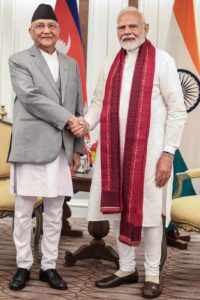Recently I was part of a panel discussion on cultural diplomacy vis-à-vis India-Nepal relations. At first glance it would appear that since India and Nepal already have millennia-old cultural ties, cultural diplomacy in this case is unnecessary overkill. But that would be a wrong assessment. If we take cultural diplomacy to be a key tool of promoting people-to-people relations, which in turn inform government-to-government relations, to serve as a safety net in times of crisis, and promote mutual interests, then India-Nepal cultural diplomacy still has a long way to go.

I say this because despite the open borders, cross-border marriages, and religious ties – Hinduism and Buddhism – a gulf in understanding exists between Indian and Nepali societies. We are close and yet distant. In fact, I call this the ‘invisibilisation paradox’ – when two parties are so close, they start taking each other for granted and invisibilise each other’s interests. This is precisely what is happening to India-Nepal ties today. Sure, there are myriad connectivity projects underway, cross-border power transmission projects are being implemented, and trade, commerce and tourism continue. Yet, we in India in particular, know little about modern-day Nepal and the changes it is undergoing.
For example, how many Indians know about Nepal’s start-up scene? Very few. How many Indians know about contemporary Nepali art, music and cultural trends? Again, a handful I assume. Yes, we know about Everest, Annapurna Base Camp, Swayambhunath, Janakpur, Lumbini and Boudhanath. But that doesn’t bring us any closer to knowing what ordinary Nepalis are thinking or what are the socio-political forces driving them today.
And this gulf in understanding can be dangerous. We recently had the unfortunate incident in Bhubaneswar’s KIIT university where hundreds of Nepali students were turned out by the college administration after they protested in the aftermath of a suicide by a fellow Nepali student. Finally, state government authorities intervened and the students were brought back to the institute. But the damage had been done. The attitude of the university staff was appalling – they were videographed talking down to the Nepali students and belittling their country.
The incident exposed utter ignorance, prejudice and stereotypes that exist in Indian society vis-à-vis Nepal. The whole thing almost led to a diplomatic row – thankfully it was diffused in time. Therefore, there is much scope for cultural diplomacy to bridge this gap in India-Nepal ties and stem this invisibilisation. I believe we must start young and promote more school-to-school interactions between Indian and Nepali students. Similarly, there is a case for greater cross-border media cooperation between the two sides to address the cognisance deficit.
Conversely, the cost of ignoring this invisibilisation is huge. An extreme example of invisibilisation is what happened to Ukraine and Russia. The ongoing Russian war of aggression against Ukraine is a direct result of Moscow trying to invibilise Ukraine over centuries. In fact, the Russian derogatory term for Ukraine is “malorossiya” or “little Russia”. As I have mentioned in an earlier article “A piano that speaks for the soul of Ukraine” numerous attempts were made to erase, ignore or ridicule Ukrainian culture.
In Soviet times this internal invisibilisation of Ukraine reached tragic heights as exemplified by the Holodomor or the man-made Ukrainian famine that was engineered by the Soviet regime against Ukrainians to snuff out nationalist aspirations. Millions of Ukrainians perished in the Holodomor due to the then Moscow leadership’s inhumane policies. The suffering of Ukrainians was invisible to the Soviet regime.
Not much seems to have changed even today. Russia’s invasion of Ukraine and relentless bombardment of Ukrainian cities that even take the lives of young children highlight the continuing invisibilisation of Ukrainian lives. The recent dastardly double-tap Russian missile strike on the Ukrainian city of Sumy on Palm Sunday that killed 35 people, including two children, exemplifies this point. Therefore, this Russian aggression stems from a deep-rooted cultural invisibilisation of Ukraine. Hence, the Ukraine war, at its core, is a deeply cultural war.
While there is no going back for Ukraine and Russia – their relations have reached a point of no return – other countries would do well to guard against the dangers of invisibilisation. India and Nepal must work harder to not just strengthen ties but also make them irreversible. And that can only happen through enhanced mutual respect and understanding.
Disclaimer
Views expressed above are the author's own.







Top Comment
{{A_D_N}}
{{C_D}}
{{{short}}} {{#more}} {{{long}}}... Read More {{/more}}
{{/totalcount}} {{^totalcount}}Start a Conversation